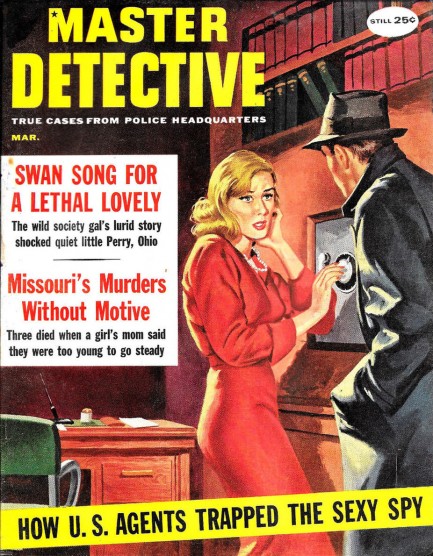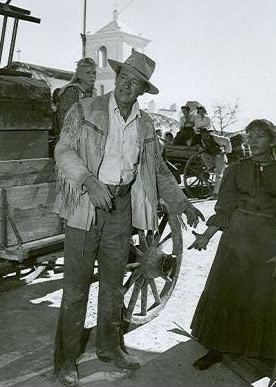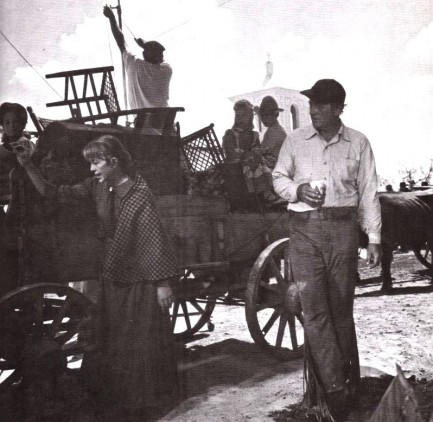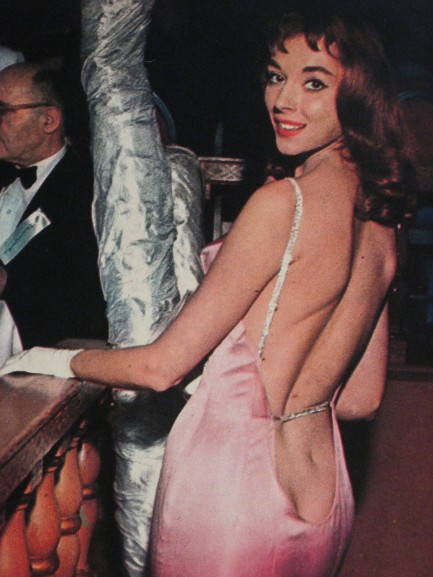 Jealous murder strikes a John Wayne movie set. 
This Master Detective published today in 1960 has a nice cover by Al Drule, and inside the issue are several interesting stories, but the one we're looking at today is “The Crime that Wasn't in the Script,” about a murder that took place during the filming of John Wayne's western The Alamo. The story is kind of forgotten, but basically, an actress named LaJean Etheridge was killed by her boyfriend Chester Harvey Smith, who was angry that Etheridge had decided to move closer to the movie set in Brackettville, Texas. Such a killing is impossible to understand under any circumstances, but putting on your jealous madman cap for a second you can picture a possessive man losing it over his girlfriend moving thousands of miles away. Like if someone told you the story you'd nod and go, “Umm hmm,” because you could see it.
 But Etheridge wasn't moving thousands of miles. She and Smith had both scored work as extras on The Alamo, had traveled from Hollywood together, and were living in Spofford, Texas with three other extras in lodgings set up by Wayne's Batjac Productions. Etheridge had decided to move from Spofford to Fort Clark, ten miles north, a relocation precipitated by her landing a larger part in the film. Was she simply moving closer to the set to facilitate the changed demands of her role? Or was she leaving her boyfriend? Still wearing your jealous madman cap, you can picture Smith believing the latter. Etheridge would be out of sight, living with unknowns, possibly having fun with production staff and carousing with handsome actors. But she never got the chance—as she was packing Smith stabbed her in the chest with a Bowie knife, and she died on the scene. He was arrested when police arrived fifteen minutes later, pled guilty to murder, and was sentenced to thirty years in prison. But Etheridge wasn't moving thousands of miles. She and Smith had both scored work as extras on The Alamo, had traveled from Hollywood together, and were living in Spofford, Texas with three other extras in lodgings set up by Wayne's Batjac Productions. Etheridge had decided to move from Spofford to Fort Clark, ten miles north, a relocation precipitated by her landing a larger part in the film. Was she simply moving closer to the set to facilitate the changed demands of her role? Or was she leaving her boyfriend? Still wearing your jealous madman cap, you can picture Smith believing the latter. Etheridge would be out of sight, living with unknowns, possibly having fun with production staff and carousing with handsome actors. But she never got the chance—as she was packing Smith stabbed her in the chest with a Bowie knife, and she died on the scene. He was arrested when police arrived fifteen minutes later, pled guilty to murder, and was sentenced to thirty years in prison.
The final assessment by Smith's lawyer was that the murder was a crime of “passion and professional jealousy.” As details emerged a clearer picture of Smith formed. He had once struck his ex-wife's roommate in the head with a hatchet, and earlier had tried to run her, her roommate, and their dates down with his car. His rage wasn't reserved only for ex-lovers. He also once attacked a bus driver. So Smith needed no excuses to hurt people. It's just what he did. But maybe this particular episode really was a so-called crime of passion. Rumors circulated during the trial that Etheridge had been seeing John Wayne, but he never testified nor was officially involved with the case in any way. And under the circumstances, it was probably inevitable that such rumors would spring up. Yet Etheridge had completed her part, and Wayne, according to several accounts, had asked her to stay on at Fort Clark. So there's no telling.
Etheridge's part in The Alamo was left on the cutting room floor. No surprise. The murder caused enough bad publicity as it was, so naturally there was no way she could have remained in the film. It wasn't until an extended version was released in 1993 that her role as Mrs. Guy was seen by movie fans. Though the story of the murder has faded somewhat, author John Hegenberger used the events as the backdrop for a 2017 crime novel called Stormfall. Chester Harvey Smith, John Wayne, and others are characters, and the star is Hegenberger's detective creation Stan Wade. The book opens with the murder, and Etheridge uttering her final words to Smith before she dies. What were the words? According to the statement Smith gave police, Etheridge said, mortally wounded and bleeding to death, “I love you.” You can take off your jealous madman cap now. faded somewhat, author John Hegenberger used the events as the backdrop for a 2017 crime novel called Stormfall. Chester Harvey Smith, John Wayne, and others are characters, and the star is Hegenberger's detective creation Stan Wade. The book opens with the murder, and Etheridge uttering her final words to Smith before she dies. What were the words? According to the statement Smith gave police, Etheridge said, mortally wounded and bleeding to death, “I love you.” You can take off your jealous madman cap now.
 Whether coming or going she was determined to make an impression. 
Above is a photo of American actress Vikki Dougan at the 1957 Foreign Press Banquet in Hollywood, California. Dougan is wearing a daring backless dress designed to generate publicity for her film career. Since Marilyn Monroe and Jayne Mansfield had a stranglehold on the bosom, Dougan and her studio handlers at Batjac Productions decided she should go the opposite direction and bare her back. To say she garnered press would be an understatement, but despite the reams of slavering coverage her career never quite ignited. She remains, however, well remembered for proving that it’s sometimes good to say yes to crack.
|
 |

The headlines that mattered yesteryear.
2003—Hope Dies
Film legend Bob Hope dies of pneumonia two months after celebrating his 100th birthday. 1945—Churchill Given the Sack
In spite of admiring Winston Churchill as a great wartime leader, Britons elect
Clement Attlee the nation's new prime minister in a sweeping victory for the Labour Party over the Conservatives. 1952—Evita Peron Dies
Eva Duarte de Peron, aka Evita, wife of the president of the Argentine Republic, dies from cancer at age 33. Evita had brought the working classes into a position of political power never witnessed before, but was hated by the nation's powerful military class. She is lain to rest in Milan, Italy in a secret grave under a nun's name, but is eventually returned to Argentina for reburial beside her husband in 1974. 1943—Mussolini Calls It Quits
Italian dictator Benito Mussolini steps down as head of the armed forces and the government. It soon becomes clear that Il Duce did not relinquish power voluntarily, but was forced to resign after former Fascist colleagues turned against him. He is later installed by Germany as leader of the Italian Social Republic in the north of the country, but is killed by partisans in 1945.
|

|
|

It's easy. We have an uploader that makes it a snap. Use it to submit your art, text, header, and subhead. Your post can be funny, serious, or anything in between, as long as it's vintage pulp. You'll get a byline and experience the fleeting pride of free authorship. We'll edit your post for typos, but the rest is up to you. Click here to give us your best shot.

|
|


 But Etheridge wasn't moving thousands of miles. She and Smith had both scored work as extras on The Alamo, had traveled from Hollywood together, and were living in Spofford, Texas with three other extras in lodgings set up by Wayne's Batjac Productions. Etheridge had decided to move from Spofford to Fort Clark, ten miles north, a relocation precipitated by her landing a larger part in the film. Was she simply moving closer to the set to facilitate the changed demands of her role? Or was she leaving her boyfriend? Still wearing your jealous madman cap, you can picture Smith believing the latter. Etheridge would be out of sight, living with unknowns, possibly having fun with production staff and carousing with handsome actors. But she never got the chance—as she was packing Smith stabbed her in the chest with a Bowie knife, and she died on the scene. He was arrested when police arrived fifteen minutes later, pled guilty to murder, and was sentenced to thirty years in prison.
But Etheridge wasn't moving thousands of miles. She and Smith had both scored work as extras on The Alamo, had traveled from Hollywood together, and were living in Spofford, Texas with three other extras in lodgings set up by Wayne's Batjac Productions. Etheridge had decided to move from Spofford to Fort Clark, ten miles north, a relocation precipitated by her landing a larger part in the film. Was she simply moving closer to the set to facilitate the changed demands of her role? Or was she leaving her boyfriend? Still wearing your jealous madman cap, you can picture Smith believing the latter. Etheridge would be out of sight, living with unknowns, possibly having fun with production staff and carousing with handsome actors. But she never got the chance—as she was packing Smith stabbed her in the chest with a Bowie knife, and she died on the scene. He was arrested when police arrived fifteen minutes later, pled guilty to murder, and was sentenced to thirty years in prison. faded somewhat, author John Hegenberger used the events as the backdrop for a 2017 crime novel called Stormfall. Chester Harvey Smith, John Wayne, and others are characters, and the star is Hegenberger's detective creation Stan Wade. The book opens with the murder, and Etheridge uttering her final words to Smith before she dies. What were the words? According to the statement Smith gave police, Etheridge said, mortally wounded and bleeding to death, “I love you.” You can take off your jealous madman cap now.
faded somewhat, author John Hegenberger used the events as the backdrop for a 2017 crime novel called Stormfall. Chester Harvey Smith, John Wayne, and others are characters, and the star is Hegenberger's detective creation Stan Wade. The book opens with the murder, and Etheridge uttering her final words to Smith before she dies. What were the words? According to the statement Smith gave police, Etheridge said, mortally wounded and bleeding to death, “I love you.” You can take off your jealous madman cap now. 





































































